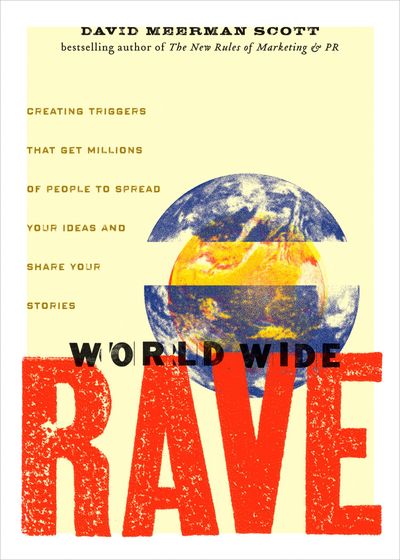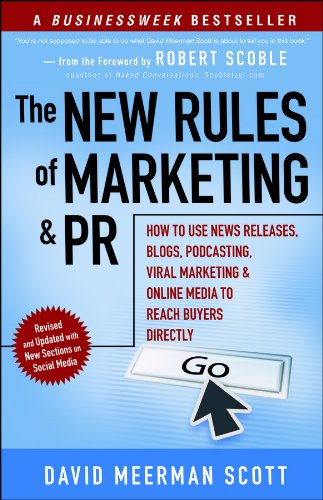I recently finished reading David Meerman Scott’s new book, the World Wide Rave. This is the second book I have read by the author. I still consider the other book that I read, the New Rules of Marketing and PR, to be the bible for social media. If you have not picked up a copy of World Wide Rave I would encourage you to do so. It is a quick read that is full of interesting case studies and guiding principles. For example, there are helpful checklists such as 10 recommendations for creating YouTube videos and 16 rules for designing great e-books. There are too many good ideas to try to comment on, but I did want to call attention to four key principles that I found particularly compelling while reading the book:
- Nobody cares about your product
- Think like a venture capitalist
- Create a catchy or controversial title
- Hire a Journalist to write content
Nobody Cares about Your Product
“Never talk about your products and services again. Instead, focus on your buyer personas and how you can solve problems for them.”
This statement cannot be repeated enough. I think the number one challenge that marketing organizations face with web 2.0 is the focus on selling their products in the content. Instead of talking about products, marketers should talk about problems that their customers face and how they can help to solve them. To reach a meaningful audience your content should not be promotional, but rather educational, entertaining and engaging. This is a significant mind-shift for most corporate marketing professionals accustomed to writing collateral that focuses on features, benefits and differentiation of individual products.
Think like a Venture Capitalist
“A typical VC follows a maxim stating that most ventures will fail, a few might do okay, and hopefully one will take off to become a large enterprise that will repay investors many times their initial investment.”
Marketing executives often get frustrated when they invest time into social media and do not realize immediate benefits. But who cares? The cost of a web 2.0 program is almost negligible when compared to traditional media. For example, if you place a full page print ad in the Wall Street Journal or spend for prime real estate at a tradeshow and do not achieve your desired goals then you have spent $50,000 with little ROI. But there is very little expense incurred with a blog – just an investment in time to write the posts. Participation in micro-blogging sites such as Twitter and Social Networks such as Facebook and LinkedIn are free. And you can buy a FlipCam for $200 and film HD videos for YouTube. You can trial and error hundreds of times while still not reaching the investment levels of traditional media. If you perform 200 different social media activities and only 1 goes viral, the ROI would still be significantly higher than print advertisements, tradeshow sponsorships and direct mail campaigns.
Create a Catchy or Controversial Title
“People are much more eager to link to a catchy or controversial title. People are intrigued by a title and want to read more.” Examples cited by David include Branding is for Cattle, Digital Masturbation and Do You Know This Person? Is it You?
Some might ask why this warrants being called out in this post, because it is a relatively simple concept. But in my experience it is one of the most important rules in social media. You are competing with content on millions of other blogs, podcasts and videos. Only a few pieces of content, less than 1%, will go viral each day. In order to stand out and get attention you need a strong title. This can make the difference between a great post that is hit 100 times and one that is hit 10,000 times. Controversy gets attention. Even if your audience doesn’t agree with the premise of your argument they will read it. And many will comment simply to reinforce their own opinions. I have utilized the controversial title in several of my Outside In Marketing posts. See Don’t Hire Industry Marketing People from Industry and Don’t Focus on What the Analysts Say about Your Industry.
Hire a Journalist to Write Content
“A good journalist can create interesting stories about how an organization solves customer problems and can then deliver those stories in a variety of forms: articles, e-books, web content, podcasts, and video. Consumers will love it. How refreshing to read, listen to and watch these products of journalistic expertise instead of the usual come-ons that typical corporations produce.”
For most companies, a controversial or catchy title will not be enough to reach their target audiences. Companies need to create content that is educational, entertaining and engaging. A key challenge is that most companies do not have the skills in-house to produce this type of material. Product managers are too busy and often narrowly focused on a particular market subsector. Marketing communications generalists lack the understanding of industry trends and product features to write any meaningful content. To rise above the noise in the web 2.0 world, companies will need to dedicate full time personnel to developing content. These content generators must produce material that is educational, entertaining and engaging. In some cases, a company may be able to take a strong writer or thought leader from their internal organization and repurpose them as a content expert. However, most will need to employ the services of a professional journalist retained on a contract or full-time basis.











